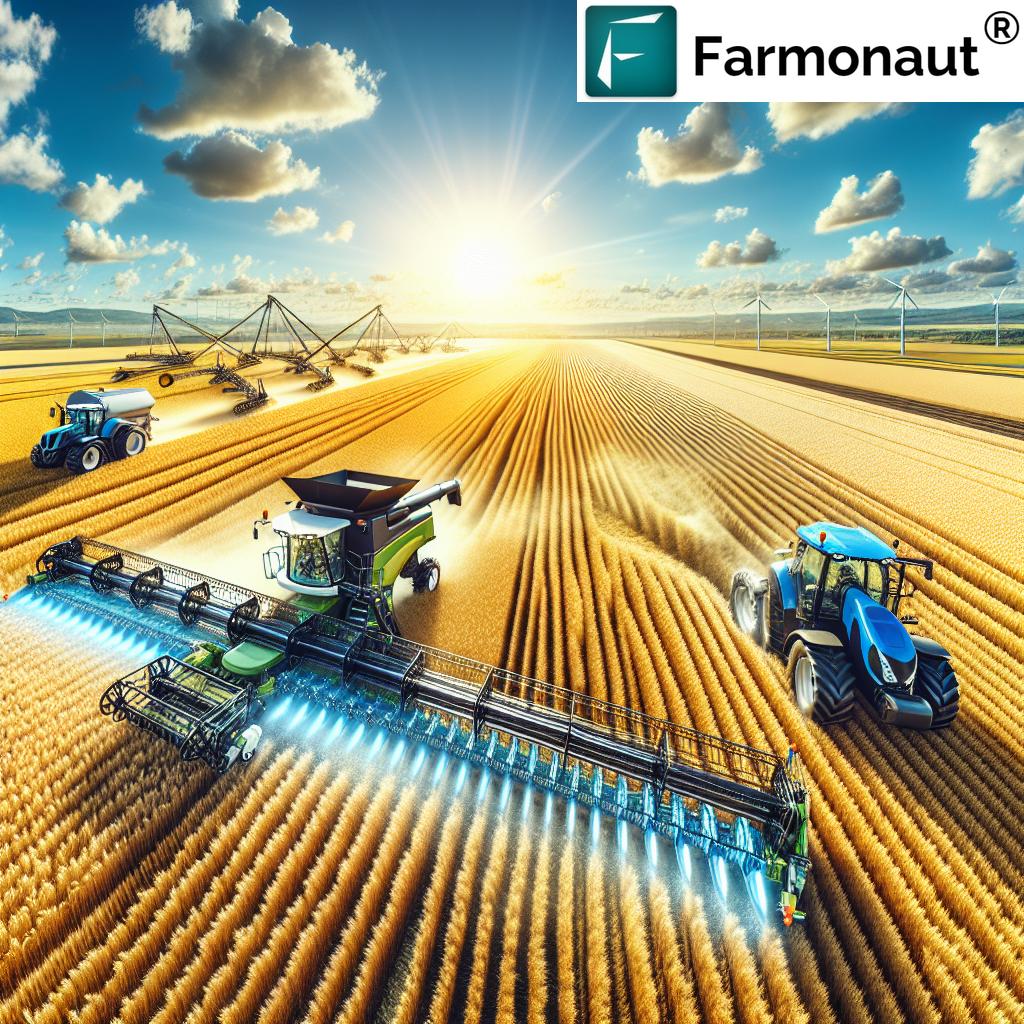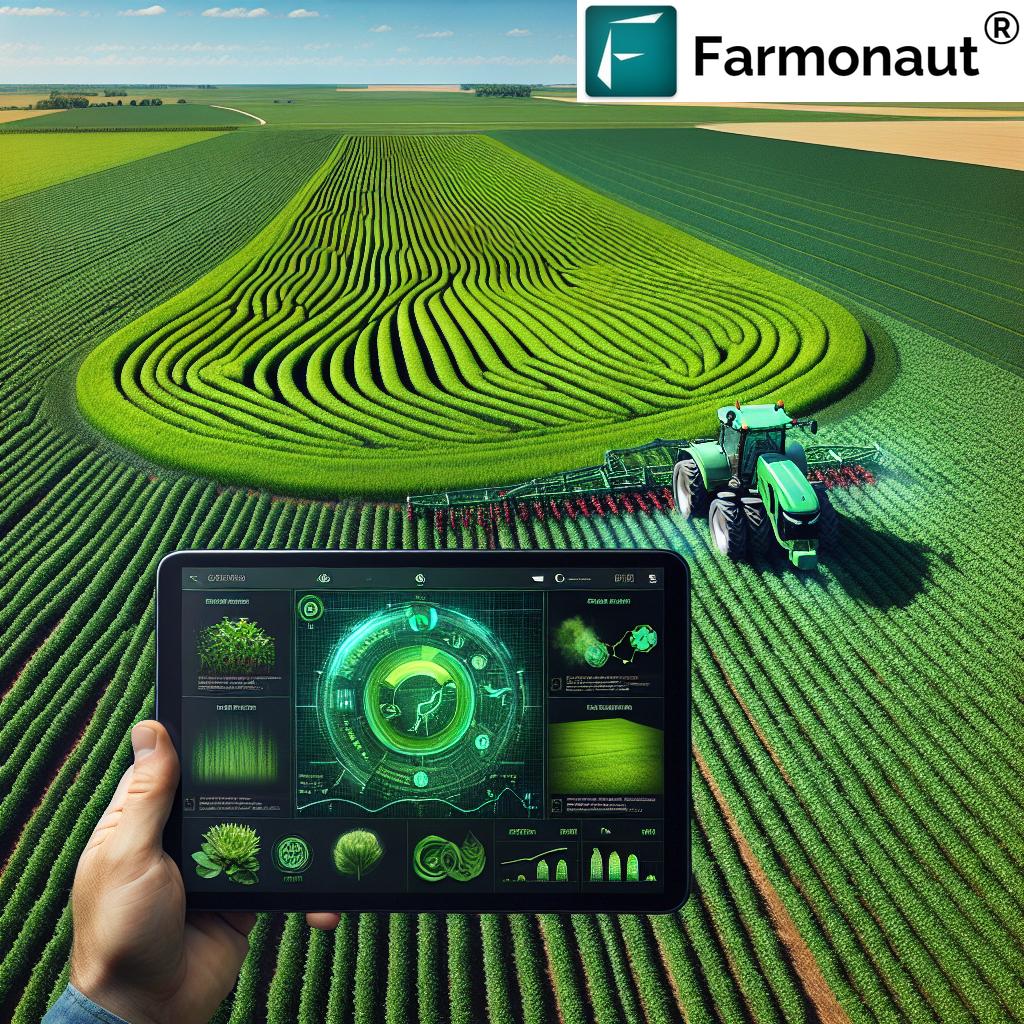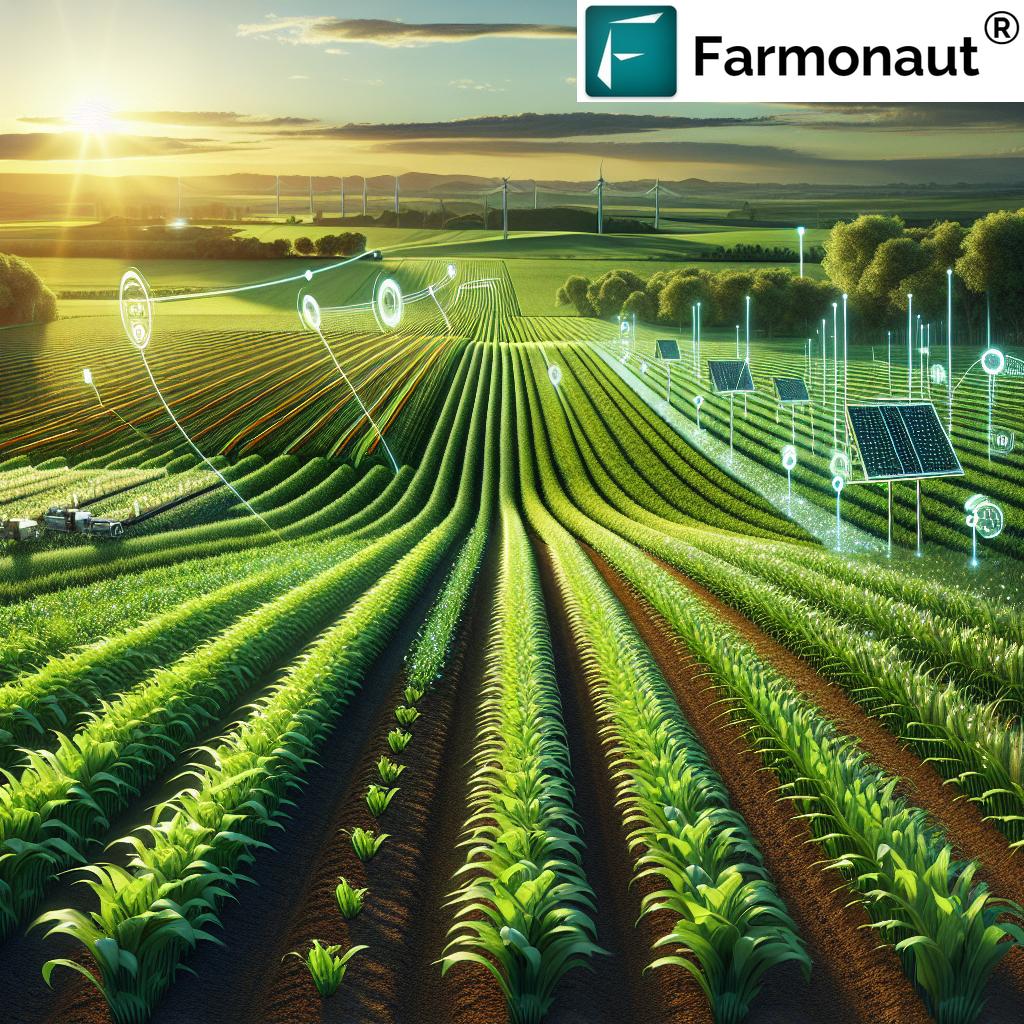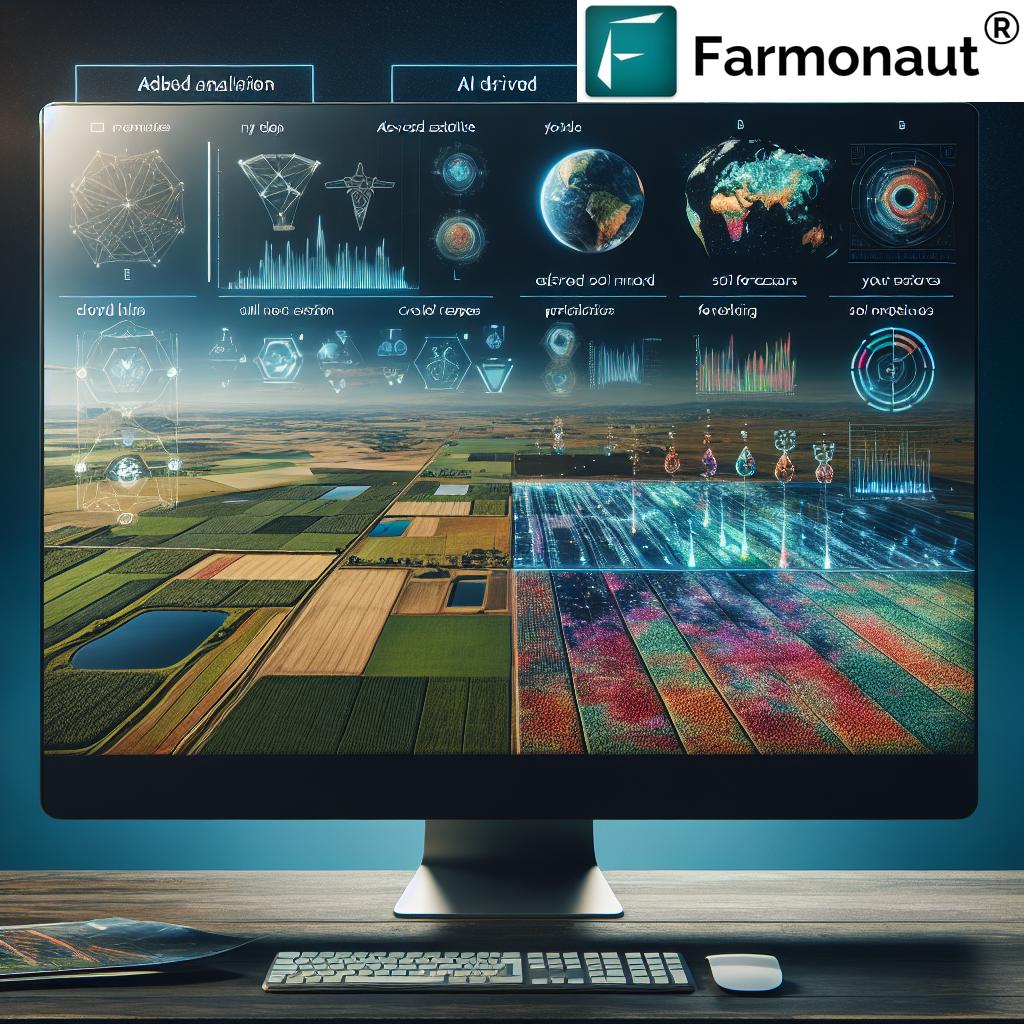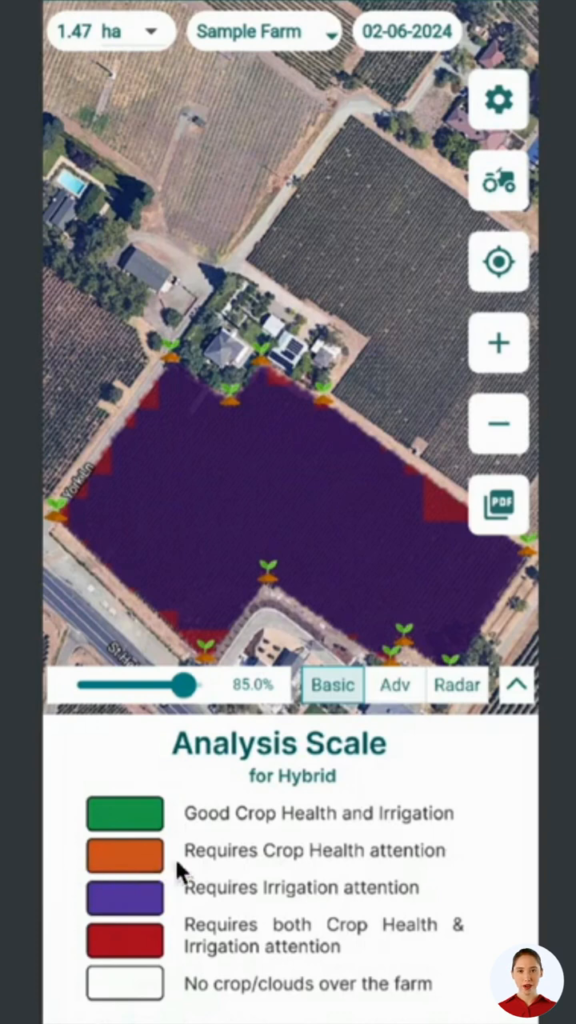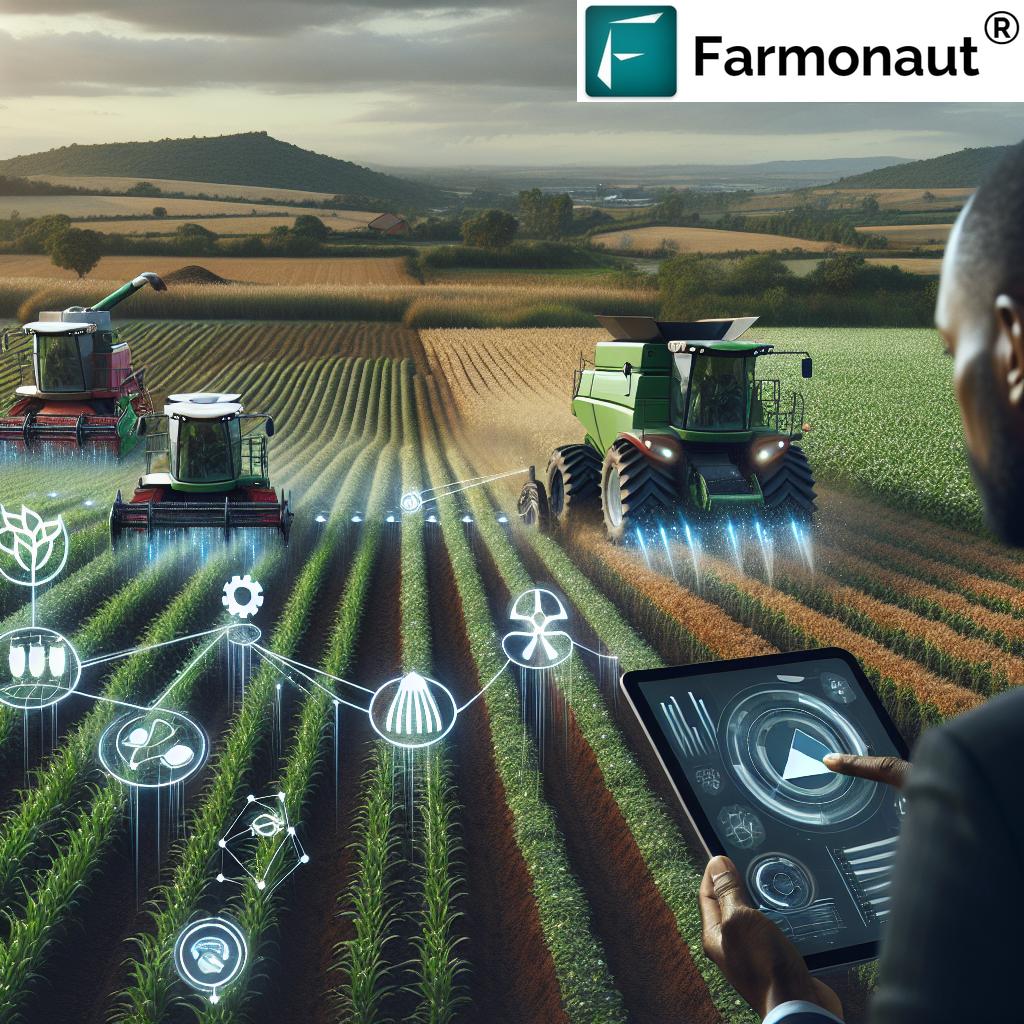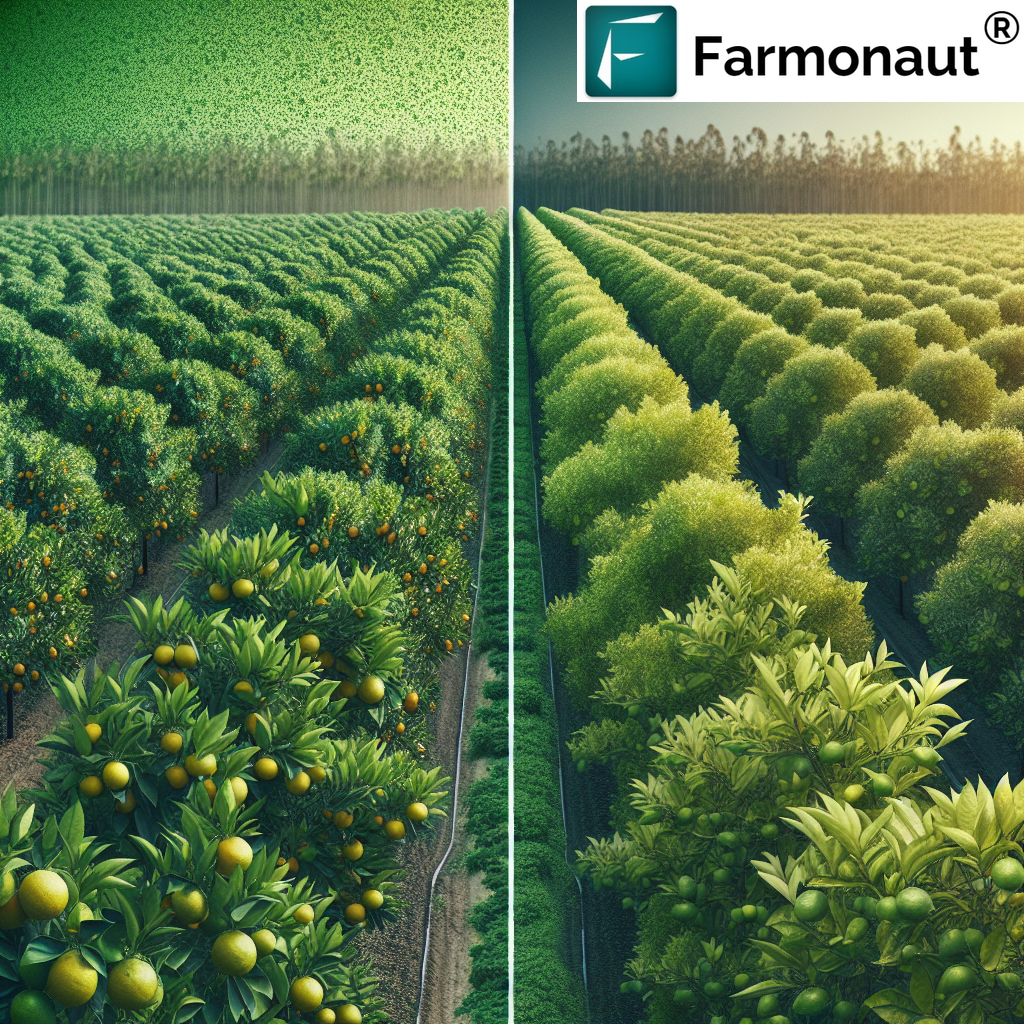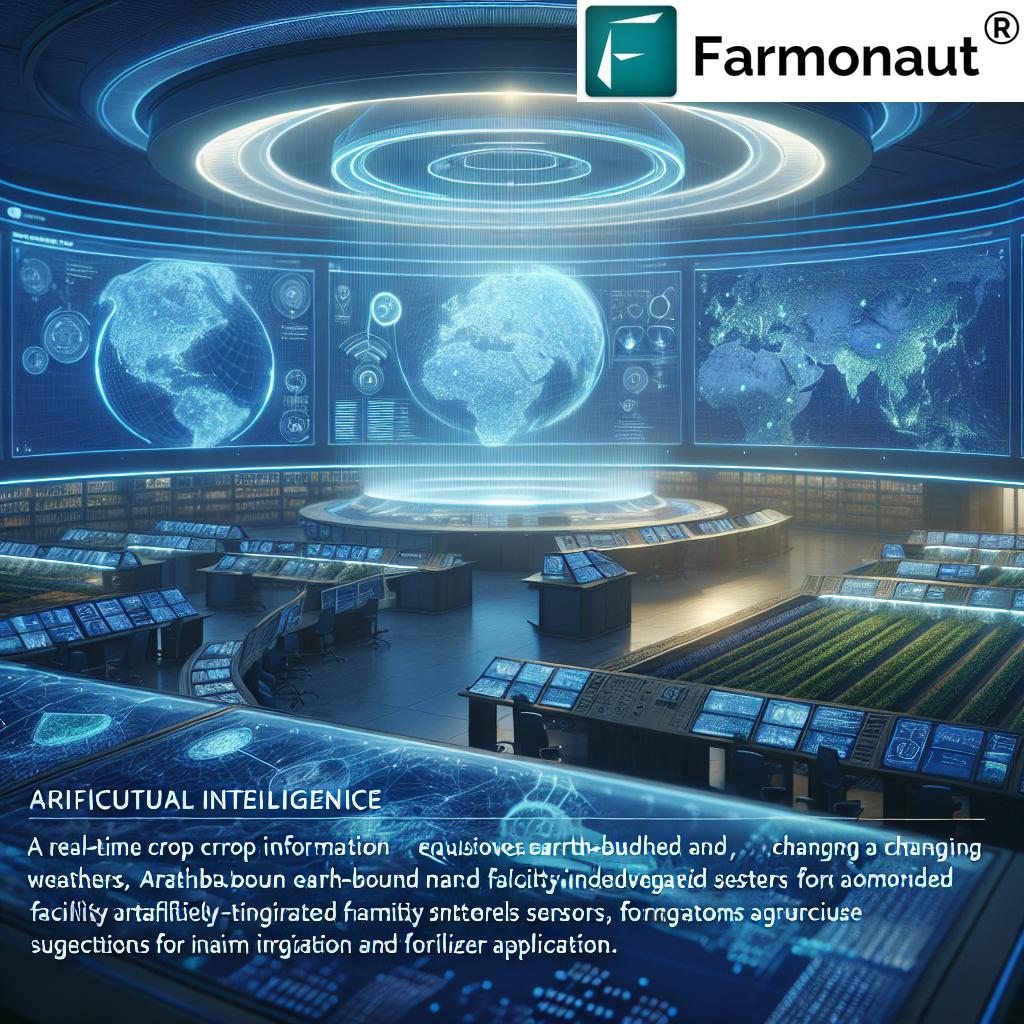Unlocking Precision Agriculture: How Farmonaut’s Tools Revolutionize Crop Yield Forecasting and Farm Data Analytics
“Precision agriculture tools have increased crop yields by up to 30% in some regions, revolutionizing farm productivity.”
In the ever-evolving landscape of modern agriculture, we find ourselves at the forefront of a technological revolution that is reshaping the way we approach farming, market analysis, and financial strategies in the agricultural sector. As we delve into the world of agricultural stock performance and crop futures trading, it becomes evident that the agtech market is experiencing unprecedented growth and transformation. At the heart of this revolution lies the innovative solutions provided by companies like Farmonaut, which are fundamentally changing how we approach crop yield forecasting and farm data analytics.
The Intersection of Agriculture and Technology
The agricultural sector is no longer confined to traditional farming methods. Today, it stands at the crossroads of cutting-edge technology and time-honored agricultural practices. This fusion has given birth to a new era of farming, where data-driven decisions and precision tools are becoming the norm rather than the exception.
- Satellite-based crop monitoring
- AI-powered advisory systems
- Blockchain for supply chain transparency
- Advanced weather forecasting
These technologies are not just buzzwords; they are the building blocks of a more efficient, sustainable, and profitable agricultural future. As we navigate through this blog post, we’ll explore how these advancements are influencing farm commodity prices, shaping agricultural sector trends, and providing farmers with the tools they need to thrive in an increasingly competitive global market.
The Rise of Precision Agriculture Tools
Precision agriculture is revolutionizing the way farms operate, offering a level of accuracy and efficiency that was once thought impossible. At the forefront of this revolution are companies like Farmonaut, which provide farmers with a comprehensive suite of tools designed to optimize every aspect of crop management.
Let’s take a closer look at some of the key precision agriculture tools that are making waves in the industry:
- Satellite-Based Crop Health Monitoring: Using multispectral satellite imagery, farmers can now track vegetation health indices like NDVI (Normalized Difference Vegetation Index) in real-time. This allows for early detection of crop stress, pest infestations, and nutrient deficiencies.
- AI-Driven Advisory Systems: Platforms like Farmonaut’s Jeevn AI provide personalized recommendations based on real-time data, historical patterns, and expert knowledge. This empowers farmers to make informed decisions about irrigation, fertilization, and pest control.
- Blockchain-Based Traceability: By implementing blockchain technology, the agricultural supply chain becomes more transparent and secure. This not only builds trust with consumers but also helps in managing quality control and reducing fraud.
- Resource Management Tools: Advanced software for fleet and resource management helps agribusinesses optimize their operations, reduce waste, and improve overall efficiency.
These tools are not just improving productivity; they’re also contributing to more sustainable farming practices by optimizing resource use and reducing environmental impact.
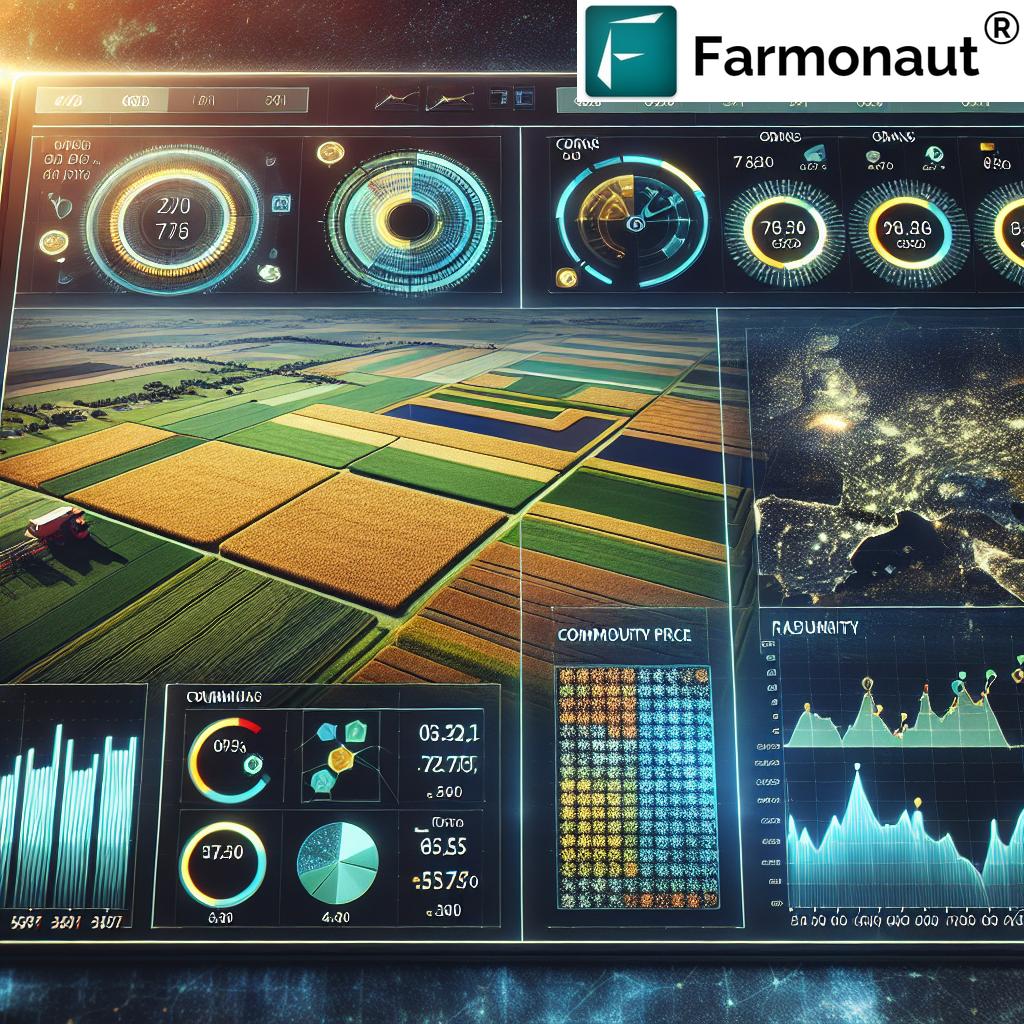
The Impact on Agricultural Financial Strategies
The advent of precision agriculture tools has had a profound impact on agricultural financial strategies. With more accurate data and predictive analytics at their fingertips, farmers and investors alike are better equipped to make informed decisions about crop selection, resource allocation, and market timing.
Here are some ways in which these tools are influencing financial strategies in agriculture:
- Risk Management: By providing more accurate yield forecasts and real-time crop health data, precision agriculture tools help farmers and investors better manage risks associated with weather, pests, and market fluctuations.
- Investment Decisions: Investors in agricultural stocks and commodities can now base their decisions on more reliable data, leading to potentially higher returns and more stable portfolios.
- Loan and Insurance Assessments: Financial institutions can use satellite-based verification to assess loan applications and insurance claims more accurately, potentially leading to better terms for farmers with proven track records of efficient management.
- Commodity Trading: Traders in agricultural futures markets can leverage real-time crop data to make more informed decisions about when to buy or sell contracts.
As we continue to explore the intersection of technology and agriculture, it’s clear that the financial landscape of farming is evolving rapidly. Those who adapt to these changes and leverage the power of data analytics are likely to gain a significant competitive advantage in the market.
Farmonaut: Pioneering the Future of Agriculture
In the realm of agtech innovation, Farmonaut stands out as a pioneer in providing accessible and affordable precision agriculture solutions. By leveraging satellite technology, artificial intelligence, and blockchain, Farmonaut is democratizing access to advanced farming tools that were once the preserve of large-scale industrial farms.
Let’s explore some of the key offerings that make Farmonaut a game-changer in the agricultural sector:
- Real-Time Crop Monitoring: Farmonaut’s satellite-based system provides up-to-date information on crop health, allowing farmers to respond quickly to potential issues.
- AI-Powered Advisory: The Jeevn AI system offers personalized recommendations based on a multitude of factors, including weather patterns, soil conditions, and historical data.
- Blockchain Traceability: For businesses concerned with supply chain transparency, Farmonaut’s blockchain solution offers unparalleled tracking and verification capabilities.
- Resource Optimization: From fleet management to carbon footprint tracking, Farmonaut provides tools to help agribusinesses operate more efficiently and sustainably.
By making these advanced tools accessible through user-friendly mobile and web applications, Farmonaut is enabling farmers of all scales to benefit from the latest advancements in agricultural technology.
The Future of Crop Yield Forecasting
Crop yield forecasting has always been a critical aspect of agricultural planning and market analysis. However, traditional methods often fell short in accuracy and timeliness. With the advent of advanced satellite imagery and machine learning algorithms, companies like Farmonaut are revolutionizing the way we predict and analyze crop yields.
Here’s how modern crop yield forecasting is changing the game:
- Increased Accuracy: By combining satellite imagery with ground-level data and historical trends, yield forecasts are becoming increasingly precise.
- Real-Time Updates: Unlike traditional methods that might provide updates once or twice a season, satellite-based systems can offer near-real-time insights into crop development.
- Large-Scale Analysis: Satellite technology allows for the monitoring of vast areas, providing valuable data for regional and national agricultural planning.
- Early Warning Systems: Advanced forecasting can detect potential issues early on, allowing farmers and policymakers to take preventive measures against crop failures.
These advancements in crop yield forecasting are not just benefiting individual farmers; they’re also having a significant impact on global food security and agricultural policy planning.
Farm Data Analytics: Turning Information into Action
In the age of big data, farm data analytics has emerged as a critical tool for agricultural success. By harnessing the power of data, farmers can make more informed decisions, optimize their operations, and ultimately increase their profitability.
Key aspects of farm data analytics include:
- Predictive Analytics: Using historical data and machine learning to forecast future trends and potential issues.
- Performance Benchmarking: Comparing farm performance against industry standards and historical data to identify areas for improvement.
- Resource Allocation Optimization: Analyzing data to determine the most efficient use of water, fertilizers, and other inputs.
- Market Trend Analysis: Using data to predict market trends and optimize crop selection and timing.
Farmonaut’s platform integrates these analytical capabilities, providing farmers with actionable insights that can significantly improve their operational efficiency and profitability.
Explore Farmonaut’s API for advanced data analytics
Sustainable Farming Technologies: A Path to the Future
As the global population continues to grow and climate change presents new challenges, the need for sustainable farming technologies has never been more pressing. Precision agriculture tools are at the forefront of this movement towards more sustainable farming practices.
Here’s how these technologies are contributing to sustainability:
- Water Conservation: Precision irrigation systems based on real-time soil moisture data can significantly reduce water usage.
- Reduced Chemical Use: By precisely targeting areas that need treatment, farmers can minimize the use of pesticides and fertilizers.
- Carbon Footprint Reduction: Tools like Farmonaut’s carbon footprint tracking help businesses monitor and reduce their environmental impact.
- Biodiversity Protection: Precision farming allows for more efficient land use, potentially reducing the need for agricultural expansion into natural habitats.
By adopting these sustainable technologies, farmers are not only reducing their environmental impact but also often seeing improvements in their bottom line through increased efficiency and resource savings.

The Agtech Market Landscape: Trends and Opportunities
“Agricultural commodity futures trading accounts for over $1 trillion in annual global transactions, shaping market trends.”
The agtech market is experiencing rapid growth and transformation, driven by technological advancements and increasing demand for sustainable and efficient farming solutions. As we analyze the current landscape, several key trends emerge:
- Consolidation and Integration: We’re seeing a trend towards consolidation in the agtech sector, with larger companies acquiring innovative startups to expand their technological capabilities.
- Focus on Data Interoperability: There’s a growing emphasis on creating systems that can seamlessly integrate data from various sources, providing more comprehensive insights.
- Increasing Investment: Venture capital and private equity firms are showing increased interest in agtech, recognizing its potential for growth and impact.
- Expansion of IoT in Agriculture: The Internet of Things (IoT) is becoming increasingly prevalent in farming, with connected devices providing real-time data on everything from soil conditions to equipment performance.
These trends are creating numerous opportunities for companies like Farmonaut, which are well-positioned to capitalize on the growing demand for advanced agricultural solutions.
Agricultural Stock Performance vs. Crop Futures Trading
Understanding the relationship between agricultural stock performance and crop futures trading is crucial for investors and farmers alike. While both are influenced by similar factors, such as weather patterns, global demand, and geopolitical events, they often exhibit different behaviors in terms of volatility and returns.
| Metric | Agricultural Company Stocks | Crop Futures |
|---|---|---|
| Average Annual Return (%) | 8-12% | 5-15% |
| Volatility Index | 15-25 | 20-35 |
| Market Capitalization ($B) | 10-100 | N/A |
| Trading Volume (Daily Average) | 1-10 million shares | 50,000-500,000 contracts |
This comparison highlights the different characteristics of agricultural stocks and crop futures, providing valuable insights for those looking to diversify their agricultural investments or hedge against market risks.
Navigating Farm Commodity Prices in a Volatile Market
The world of farm commodity prices is notoriously volatile, influenced by a complex web of factors ranging from weather patterns to global trade policies. For farmers and investors alike, navigating this landscape requires a combination of experience, data analysis, and strategic planning.
Here are some key strategies for managing commodity price risks:
- Diversification: Planting a variety of crops or investing in different agricultural sectors can help mitigate the risk of price fluctuations in any single commodity.
- Futures Contracts: Utilizing futures contracts can provide price certainty for farmers and a hedge against market volatility for investors.
- Data-Driven Decision Making: Leveraging tools like Farmonaut’s AI-powered advisory system can provide valuable insights into market trends and optimal timing for buying or selling.
- Long-Term Contracts: For some farmers, entering into long-term supply contracts with buyers can provide price stability and reduce exposure to short-term market fluctuations.
By combining these strategies with the real-time data and analytics provided by advanced agtech platforms, farmers and investors can better position themselves to thrive in the ever-changing agricultural market.
The Role of Remote Sensing and GIS in Modern Agriculture
Remote sensing and Geographic Information Systems (GIS) have become indispensable tools in modern agriculture, revolutionizing the way we monitor, analyze, and manage agricultural lands. These technologies provide a bird’s-eye view of farmlands, offering insights that would be impossible to gather through traditional ground-based methods alone.
Key applications of remote sensing and GIS in agriculture include:
- Crop Health Monitoring: Satellite imagery can detect early signs of crop stress, disease, or pest infestations.
- Yield Prediction: By analyzing historical data and current crop conditions, GIS can help forecast yields with increasing accuracy.
- Land Use Planning: GIS tools assist in optimal land use decisions, considering factors like soil type, topography, and climate.
- Precision Agriculture: Remote sensing data feeds into precision agriculture systems, enabling targeted application of inputs like water and fertilizers.
Farmonaut’s platform leverages these technologies to provide farmers with actionable insights, helping them make data-driven decisions that can significantly improve their productivity and sustainability.
Learn more about Farmonaut’s API Developer Docs
The Future of Agricultural Financial Strategies
As we look to the future, it’s clear that agricultural financial strategies will continue to evolve, driven by technological advancements and changing market dynamics. Some key trends to watch include:
- Integration of Real-Time Data: Financial decisions will increasingly be based on real-time data from sources like satellite imagery and IoT devices.
- AI-Driven Risk Assessment: Artificial intelligence will play a larger role in assessing and managing agricultural risks.
- Blockchain in Agricultural Finance: Blockchain technology may revolutionize areas like supply chain financing and crop insurance.
- Sustainable Finance: There will likely be a growing emphasis on financial products that incentivize sustainable farming practices.
As these trends unfold, platforms like Farmonaut that combine multiple technologies and data sources will be well-positioned to provide valuable insights and tools for agricultural financial planning.
Conclusion: Embracing the Agricultural Revolution
As we’ve explored throughout this blog post, the agricultural sector is undergoing a profound transformation, driven by technological advancements and the pressing need for sustainable, efficient farming practices. From precision agriculture tools to advanced crop yield forecasting and farm data analytics, the tools available to today’s farmers and agricultural businesses are more powerful than ever before.
Companies like Farmonaut are at the forefront of this revolution, providing accessible, affordable solutions that leverage satellite technology, AI, and blockchain to empower farmers of all scales. As we move forward, the integration of these technologies with traditional farming practices will be crucial in addressing global food security challenges and creating a more sustainable agricultural future.
For investors, traders, and anyone interested in the agricultural sector, staying informed about these technological advancements and market trends is essential. The landscape of agricultural stock performance, crop futures trading, and farm commodity prices is becoming increasingly data-driven, offering new opportunities for those who can effectively leverage these insights.
As we continue to unlock the potential of precision agriculture and farm data analytics, we can look forward to a future where farming is not only more productive and profitable but also more sustainable and resilient in the face of global challenges.
Farmonaut Subscriptions
Frequently Asked Questions
Q: What is precision agriculture?
A: Precision agriculture is a farming management concept that uses technology to observe, measure, and respond to inter and intra-field variability in crops. It aims to optimize returns on inputs while preserving resources.
Q: How does Farmonaut’s satellite-based crop monitoring work?
A: Farmonaut uses multispectral satellite imagery to monitor crop health. This technology can detect various aspects of crop health, including vegetation indices like NDVI, which helps in identifying areas of stress or potential issues in the field.
Q: What are the benefits of using AI in agriculture?
A: AI in agriculture can provide personalized recommendations, automate decision-making processes, predict crop yields, detect pests and diseases early, and optimize resource use, leading to increased productivity and sustainability.
Q: How does blockchain technology benefit the agricultural sector?
A: Blockchain in agriculture enhances supply chain transparency, improves traceability of products, reduces fraud, and can streamline processes like payments and insurance claims.
Q: What factors influence agricultural stock performance?
A: Agricultural stock performance is influenced by factors such as crop yields, commodity prices, weather conditions, global demand, technological advancements, and government policies.







